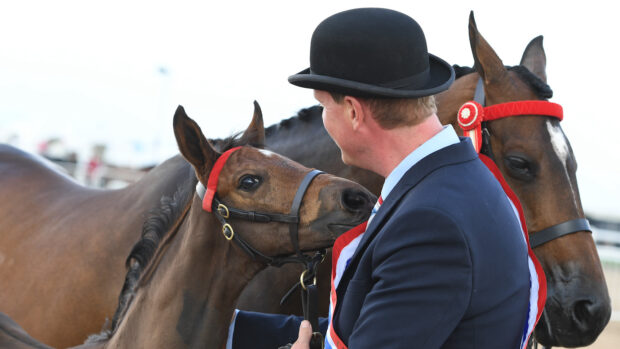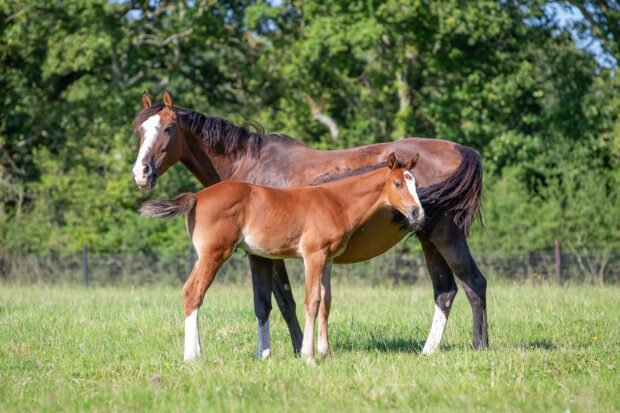More articles on broodmares
Find a stallion or stud
Breeding horses is a time-consuming and expensive business. To optimise their chances, owners need to know before the breeding season how best to ensure their mares are free from any diseases that could not only reduce the likelihood of conception, but also severely disrupt breeding activity at the stud.
While unforeseen problems can always occur even with the ideal broodmare, there are procedures that help to decide if a mare is suitable for breeding. This does not refer only to the quality of the horse or its temperament — rather it is an assessment of the reproductive health of that particular mare. Collectively, these procedures are known as the breeding soundness examination.
Venereal or sexually transmitted infection is a risk, and swabs are taken as an essential health precaution. A swab is a small piece of cotton wool twisted on to the end of a thin plastic rod. The cotton wool is touched on the part of the reproductive tract to be checked for bacteria, then sent to a laboratory.
What swabs are needed?
The mare’s clitoris (just inside the vulva) is swabbed to look for bacteria that are venereally transmitted. These bacteria are very important because they can cause reduced fertility and are difficult to treat successfully. The clitoral swab does not have to be taken when the mare is in season and can be also taken from pregnant mares before they foal.
In confirmed cases of certain venereal diseases, the law prevents the movement of horses on and off the premises. This can have devastating consequences for a breeding enterprise.
It is preferable to swab the mare before she goes to the stud (as long as this is after 1 January). This is for two reasons: the result is not available for seven days and, more importantly, if positive, the mare can be treated before being sent to stud.
Once the all-clear has been given, mares are issued with a laboratory certificate confirming their disease-free status in the current breeding season. A mare must not be used for breeding until all swab results are negative and the certificate has been shown to the stallion owner. In many cases, mares are simply carriers of venereal disease and show no outward signs of infection.
Poor hygiene measures can also spread disease and it is vital that strict precautions are in place and adhered to when working with breeding animals. Handlers must take great care to ensure that infection is not carried from one animal to another.
In many cases, a swab of the lining of the uterus (womb) will be taken to see if there are any bacteria present or signs of inflammation — known as endometritis. This swab must be taken when the mare is in season, and mares should be free from endometritis before being covered to maximise the chances of a successful breeding.
Taking the right precautions
In any breeding season, the safest option is to blood-test mares for EVA after 1 January and within 28 days before covering. A mare should not go to stud until the results are available. Stallions also need to be EVA-free.
As well as these vital tests, your vet should also check every mare before she goes to stud. This includes checking the mare on the outside — in particular the vulva, as this provides the first barrier to protect the uterus from infection. If the vulval lips do not provide a good seal then air, bacteria and dirt can enter the vagina, resulting in infection. A minor operation, performed under local anaesthetic, can be used to reduce the vulval opening and so prevent contamination of the vagina
The vet also checks the mare internally by inserting an arm via the rectum. Using a systematic approach, the ovaries, uterus and cervix are checked. Usually, the vet will also use an ultrasound machine. The vagina and cervix will also be checked visually using a speculum, a narrow tube down which the vet can shine a light. Damage to the cervix, resulting in tearing or scarring, most often occurs during foaling. This is especially the case if the foaling was difficult.
In some cases, a small biopsy of the lining of the mare’s uterus may be taken for examination under a microscope. This can help assess the likelihood of the mare becoming pregnant and carrying a foal. Mares with a lot of scar tissue (fibrosis) in their uterus have a poor chance and may not be worth sending to stud.
Ultrasonography provides another method of assessing the uterus. This can pick up uterine cysts which may reduce the likelihood of the mare becoming pregnant. An ultrasound examination will also show if fluid is present in the uterus. Any fluid should be cleared before breeding.
Further information
An excellent booklet produced by the Horserace Betting Levy Board gives codes of practice for the control of equine venereal diseases, as well as control measures for equine viral arteritis, equine herpes virus and strangles. This code is updated annually and should be read by all breeders. Copies are available from the Horserace Betting Levy Board, the Thoroughbred Breeders’ Association and the welfare department of the British Horse Society.
This veterinary feature was first published in Horse & Hound (3 February, ’05)
Looking for more articles on broodmares?
Find a stallion or stud near you



